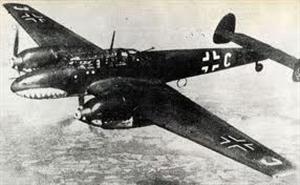Ground Attack Aircraft in Luftwaffe
Ground Attack Aircraft in Luftwaffe
Ground attack is the use of aircraft to provide close support to troops in the battlefield. The effectiveness of air attack on ground targets, in term of destructiveness and lethality, was considerably less than might be expected from the quantity of firepower that can be mounted on a relatively small aircraft. This was due in large part to the inaccuracy inherent in finding and attacking a target while passing over it at great speed and in the relative instability of the aircraft as a weapon platform, in comparison with ground-based weapons. Nonetheless, aircraft demonstrated that they could have an important role in supporting troops when artillery support was limited or could not reach targets effectively. Groundattack aircraft also had a tremendous influence on ground troops’ morale—a very negative effect upon troops being attacked and a positive one on those being supported.
Ground attackers (called Zerstörer in German—destroyers) were organized into Schlachtgeschwader (battle or attack groups) with distinctive, low-altitude missions and tasks. For example, they could spot and attack targets from above, weaken enemy defenses, support hard-pressed friendly troops, destroy enemy supply dumps, help repulse an offensive, and add to the general demoralization of the retreating enemy. These advantages justified the design and employment before and during World War II of specialist battlefield-support aircraft such as the mass-produced Messerschmitt Bf 110.
 From the start, the Luftwaffe was strongly geared toward tactical strike support of ground forces. Such an emphasis suited Hitler who saw his conquests being achieved quickly using concentrated ground and air forces on the battlefield. For such tactics, complete mastery of the air was a requirement. In the early campaigns, the skies were swept clear of opposition by sudden attacks on enemy airfields followed by destruction in the air of aircraft which had escaped. Without such freedom from enemy fighter interception, dive bombers and ground attackers were vulnerable. With the advent of appreciable Allied fighter strength, dive bombing and ground attack in daytime could continue only in areas where the enemy lacked fighter strength. By the end of the war, when Germany was forced to a defensive strategy, Stukas and Zerstörer, which were regarded primarily as offensive and tactical weapons, were relegated to limited sorties, chiefly at night.
From the start, the Luftwaffe was strongly geared toward tactical strike support of ground forces. Such an emphasis suited Hitler who saw his conquests being achieved quickly using concentrated ground and air forces on the battlefield. For such tactics, complete mastery of the air was a requirement. In the early campaigns, the skies were swept clear of opposition by sudden attacks on enemy airfields followed by destruction in the air of aircraft which had escaped. Without such freedom from enemy fighter interception, dive bombers and ground attackers were vulnerable. With the advent of appreciable Allied fighter strength, dive bombing and ground attack in daytime could continue only in areas where the enemy lacked fighter strength. By the end of the war, when Germany was forced to a defensive strategy, Stukas and Zerstörer, which were regarded primarily as offensive and tactical weapons, were relegated to limited sorties, chiefly at night.
